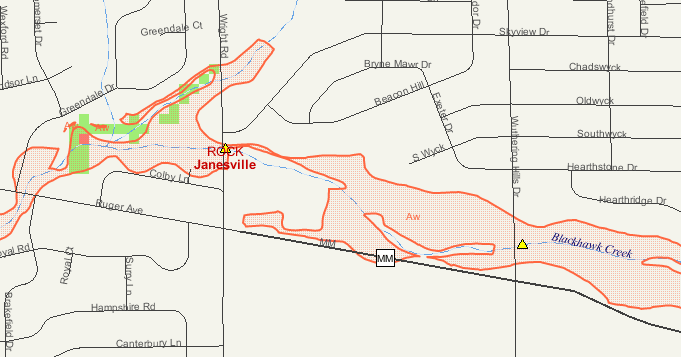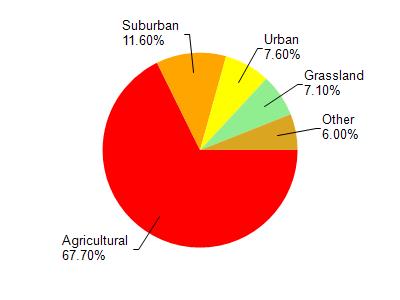
2 Miles
2 - 4
Cool-Cold Mainstem, Coldwater
2015
Poor
Degraded Habitat, Turbidity
Sediment/Total Suspended Solids
Rock
No
No
Yes
Fish and Aquatic Life
Historical Description
From: Ball, Joseph R., and Ronald J. Poff, Lake and Stream Classification Project. Surface Water Resources of Rock County, Department of Natural Resources, 1970.
Surface Acres = 6.44, Miles -2.7, Gradient = 51.8 feet per mile.
An intermittent stream included in this section because it is named The stream drains a large portion of east central Rock County and is tributary to Spring Brook near Janesville. A few forage species may enter the stream when water is present.
Date 1970
Author Surface Water Inventory Of Wisconsin
Condition
Wisconsin has over 84,000 miles of streams, 15,000 lakes and milllions of acres of wetlands. Assessing the condition of this vast amount of water is challenging. The state's water monitoring program uses a media-based, cross-program approach to analyze water condition. An updated monitoring strategy (2015-2020) is now available. Compliance with Clean Water Act fishable, swimmable standards are located in the Executive Summary of Water Condition in 2018. See also the 'monitoring and projects' tab.
Reports
Recommendations
Citizen-Based Stream Monitoring
Collect chemical, physical, and/or biological water quality data to assess the current overall stream health. The data can inform management decisions and may be used to identify impaired waters for biennial lists.
Monitor Aquatic Biology
Conduct biological (mIBI or fIBI) monitoring on Blackhawk Creek, WBIC: 797000, AU:5720253
TMDL (USEPA) Approved
Blackhawk Creek TMDL Approved
Restore Wetlands
This water is experiencing agricultural growth pressures and development pressures. There are a substantial number of "lost" wetlands along the streambank of Blackhawk creek that are considered "potentially restorable".
Management Goals
Wisconsin's Water Quality Standards provide qualitative and quantitative goals for waters that are protective of Fishable, Swimmable conditions [Learn more]. Waters that do not meet water quality standards are considered impaired and restoration actions are planned and carried out until the water is once again fishable and swimmable
Management goals can include creation or implementation of a Total Maximum Daily Load analysis, a Nine Key Element Plan, or other restoration work, education and outreach and more. If specific recommendations exist for this water, they will be displayed below online.
Monitoring
Monitoring the condition of a river, stream, or lake includes gathering physical, chemical, biological, and habitat data. Comprehensive studies often gather all these parameters in great detail, while lighter assessment events will involve sampling physical, chemical and biological data such as macroinvertebrates. Aquatic macroinvertebrates and fish communities integrate watershed or catchment condition, providing great insight into overall ecosystem health. Chemical and habitat parameters tell researchers more about human induced problems including contaminated runoff, point source dischargers, or habitat issues that foster or limit the potential of aquatic communities to thrive in a given area. Wisconsin's Water Monitoring Strategy was recenty updated.
Grants and Management Projects
Monitoring Projects
| WBIC | Official Waterbody Name | Station ID | Station Name | Earliest Fieldwork Date | Latest Fieldwork Date | View Station | View Data |
|---|
| 797000 | Blackhawk Creek | 10010925 | Blackhawk Creek - Blackhawk Creek At Henke Road | 10/16/2008 | 9/28/2015 | Map | Data |
|
Monitoring Studies
Blackhawk Creek is monitored through the Citizen Based Stream Monitoring Program, from 2008 through the present day, Blackhawk Creek at STH 14. Notes indicate that a CAFO dairy farm was constructed near the creek and monitoring to evaluate constrution run-off to this stream and permitted activity are inspected by Rock Co. Land Conservation Department. 2009-2011 Dissolved Oxygen readings ranged from 8 mg/L to 11 mg/ and an HBI value of 4.786 at that site in 2008 indicated generally good water quality conditions. Near this station, a few large acreage farmers signed up for nutrient management for new Farmland Preservation per acre tax credit. The planned CAFO rents about 5000 acres for manure. A macroinvertebrate Index of Biological Integrity value of 3.72881 for this site in 2008 indicates "fair" conditions.
Date 2011
Author Aquatic Biologist

Watershed Characteristics
Blackhawk Creek is located in the Blackhawk Creek watershed which is 108.11 mi². Land use in the watershed is primarily agricultural (67.70%), suburban (11.60%) and a mix of urban (7.60%) and other uses (13.10%). This watershed has 94.55 stream miles, 96.88 lake acres and 415.15 wetland acres.
Nonpoint Source Characteristics
This watershed is ranked Low for runoff impacts on streams, Not Ranked for runoff impacts on lakes and High for runoff impacts on groundwater and therefore has an overall rank of High. This value can be used in ranking the watershed or individual waterbodies for grant funding under state and county programs.However, all waters are affected by diffuse pollutant sources regardless of initial water quality. Applications for specific runoff projects under state or county grant programs may be pursued. For more information, go to surface water program grants.
Blackhawk Creek is considered a Cool-Cold Mainstem, Coldwater under the state's Natural Community Determinations.
Natural communities (stream and lake natural communities) represent model results and DNR staff valiation processes that confirm or update predicted conditions based on flow and temperature modeling from historic and current landscape features and related variables. Predicated flow and temperatures for waters are associated predicated fish assemblages (communities). Biologists evaluate the model results against current survey data to determine if the modeled results are corect and whether biological indicators show water quaity degradation. This analysis is a core component of the state's resource management framework. Wisconsin's Riverine Natural Communities.
Cool (Cold-Transition) Mainstem streams are moderate-to-large but still wadeable perennial streams with cold to cool summer temperatures. Coldwater fishes are common to uncommon, transitional fishes are abundant to common, and warm water fishes are uncommon to absent. Headwater species are common to absent,
mainstem species are abundant to common, and river species are common to absent.